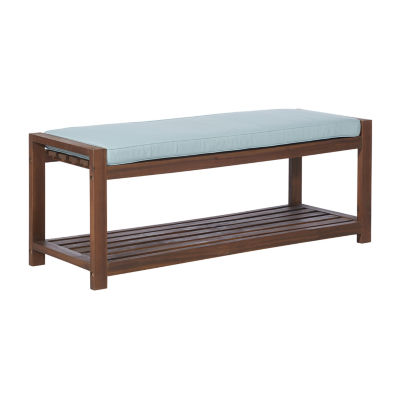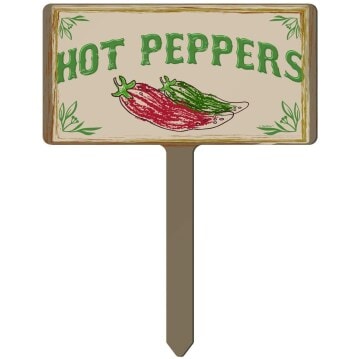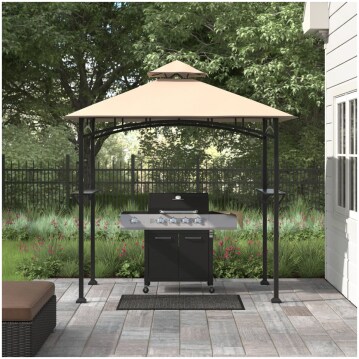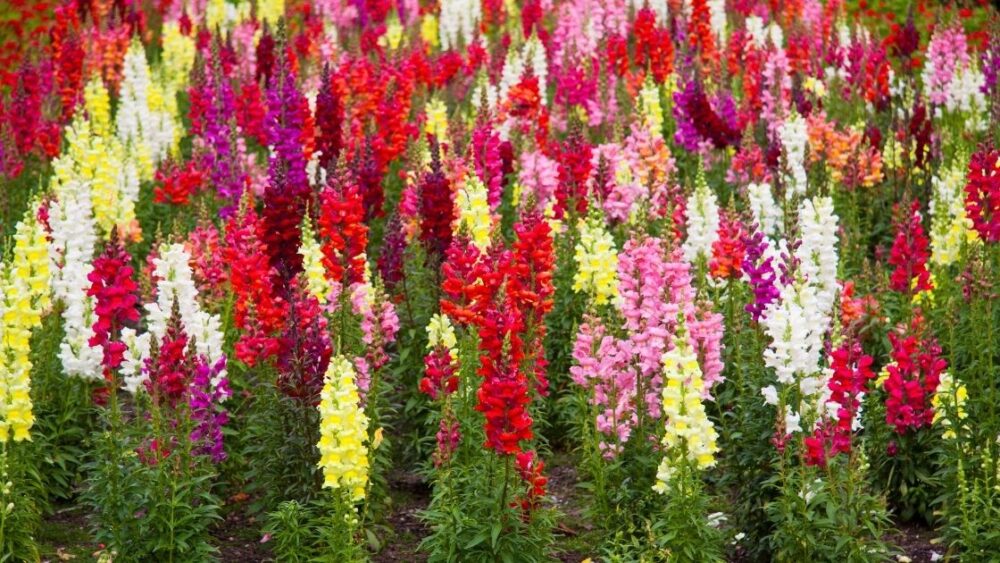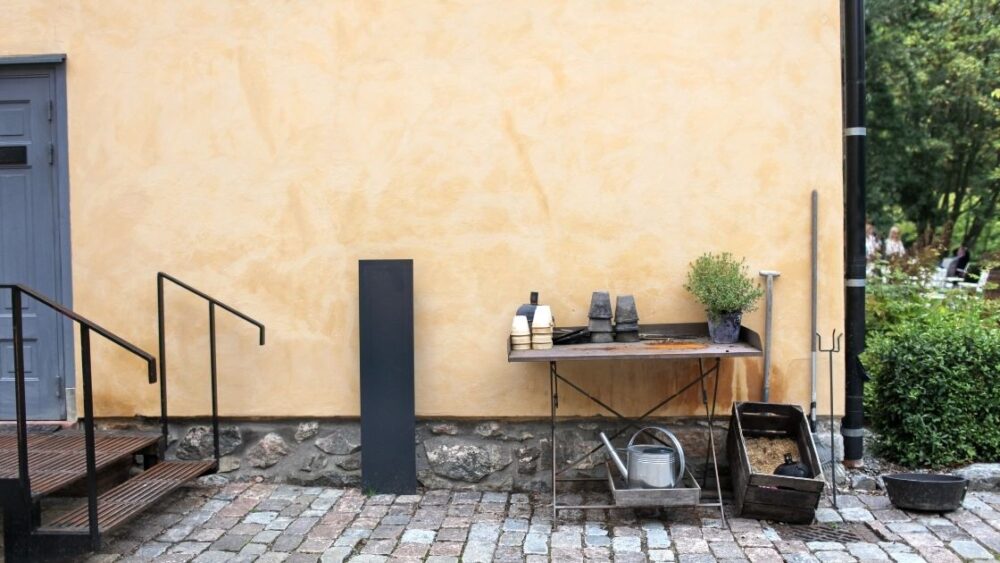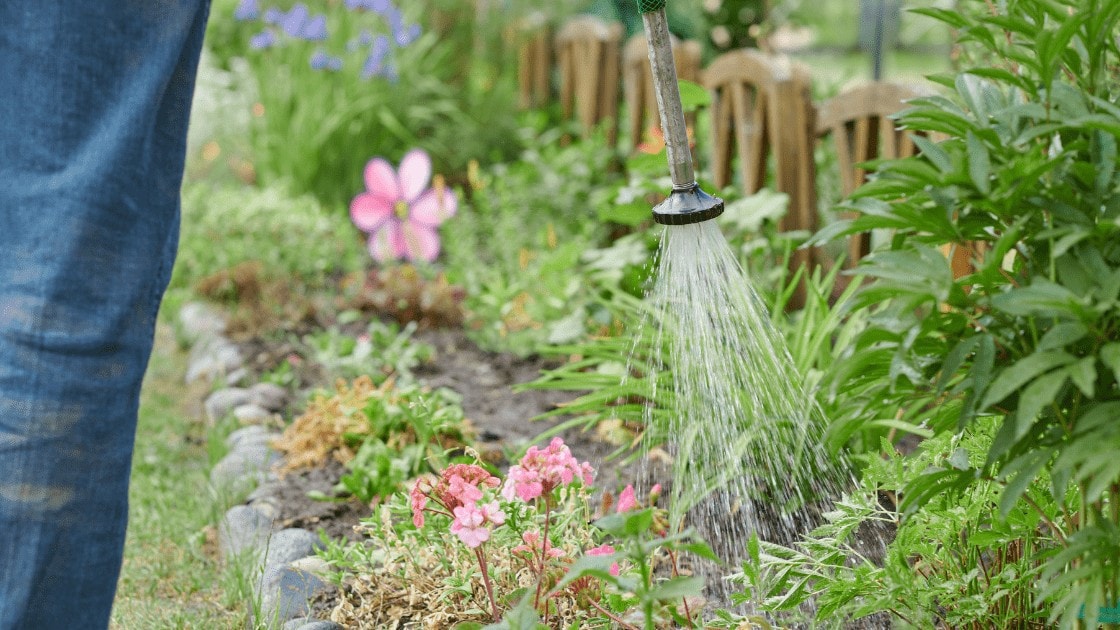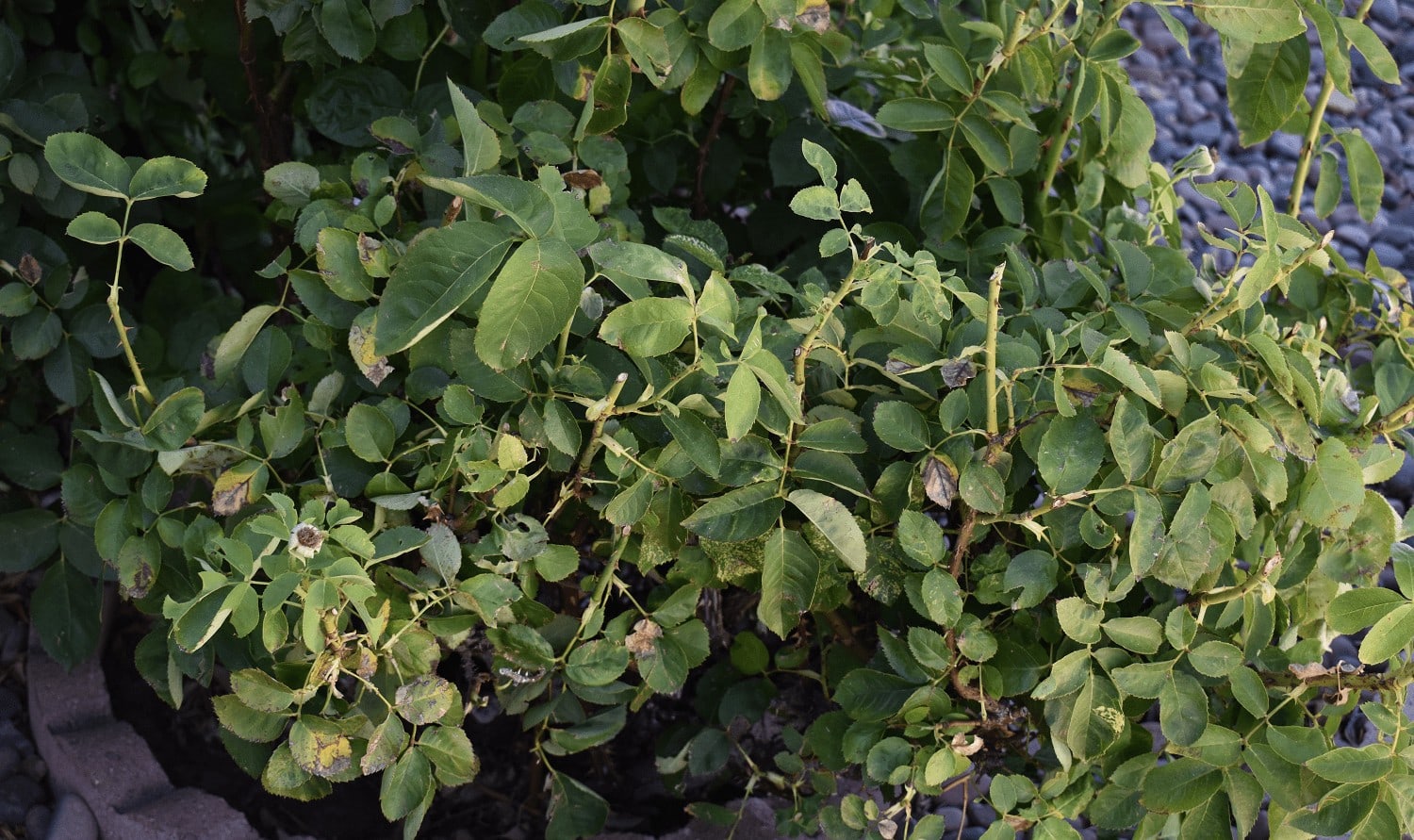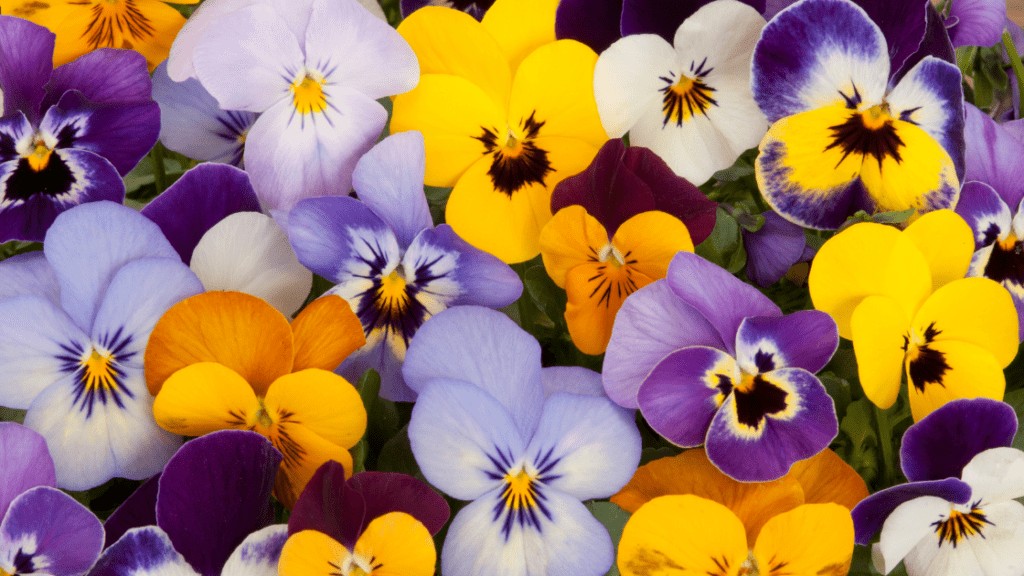
Pansies grow very well in pots, as well as in outdoor garden beds and are very easy to start from seed. There are a large number of differently colored varieties to choose from, all of which produce very large flowers that easily reach 4 inches in diameter. Pansy flowers also have a pleasant, perfume-like scent. In this article, we’ll take a look at the seven most unique pansy varieties and will give you all the information you need in order to care and propagate them!
Origin of Pansies / General Description
Pansies belong to the Viola genus. However, the name ‘Viola’ is commonly used to refer to the non-hybridized Viola varieties, which have much smaller flowers compared to Pansies.
Pansies are cross-bred Viola varieties with a somewhat unclear origin and their cross-breeding started as far back as the beginning of the 1800s. By the middle of the 19th century, dozens of differently-colored varieties with large flowers were already popular and seeds were widely sold in many European countries.
Browse our Affiliate Products
Pansies are mostly biennial plants (dying after two years of cultivation), but they are often grown as annuals because of their quick development and relatively short time to reach flowering.
Checkout our YouTube Pansy walkthrough @ Home Depot below.
7 Unique Eye-Catching Pansy Varieties
There are countless Pansy varieties to choose from and many of them are multi-colored with interesting patterns on their petals. Pansies are one of few plants that have a variety which has completely black flowers (‘Pansy Black’). With a few exceptions, viola varieties which are called ‘Pansies’ are a Viola x Wittrockiana hybrid. Here are seven popular, eye-catching varieties:
‘Matrix Blue Blotch’ (Viola x Wittrockiana)
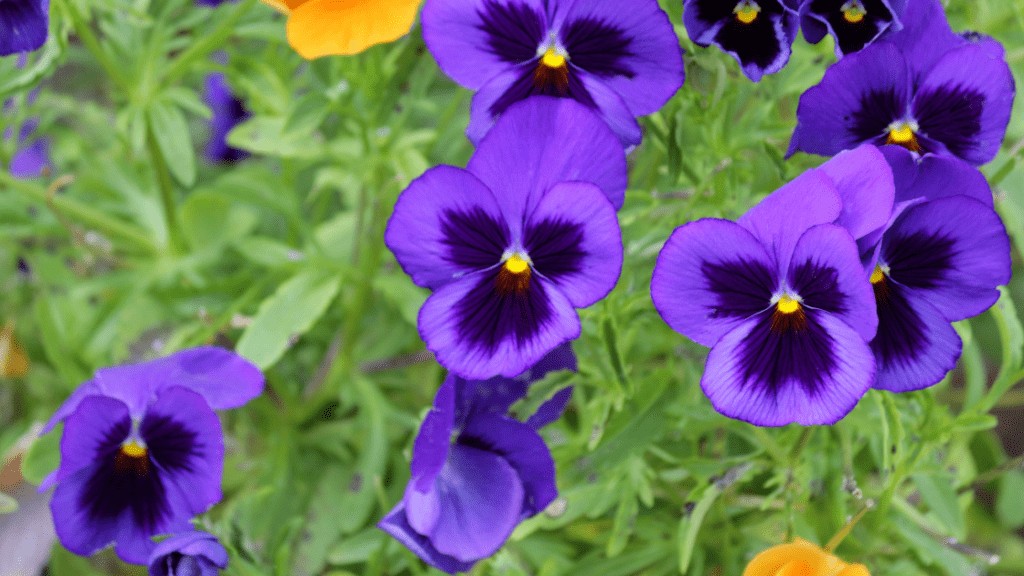
A beautiful variety that flowers in royal blue, with a dark ‘blotch’ in the center.
Of all the blue-flowering ornamental plants, this Pansy probably has the most visually-appealing blue-colored flower – royal blue is a relatively rare color in the plant kingdom and most blue-flowering plants only flower in light shades of blue, often with some white mixed-in. When grown in a garden bed, the large number of blue flowers of this variety are definitely an eye-catcher.
‘Frizzle Sizzle Blue’ (Viola x Wittrockiana)
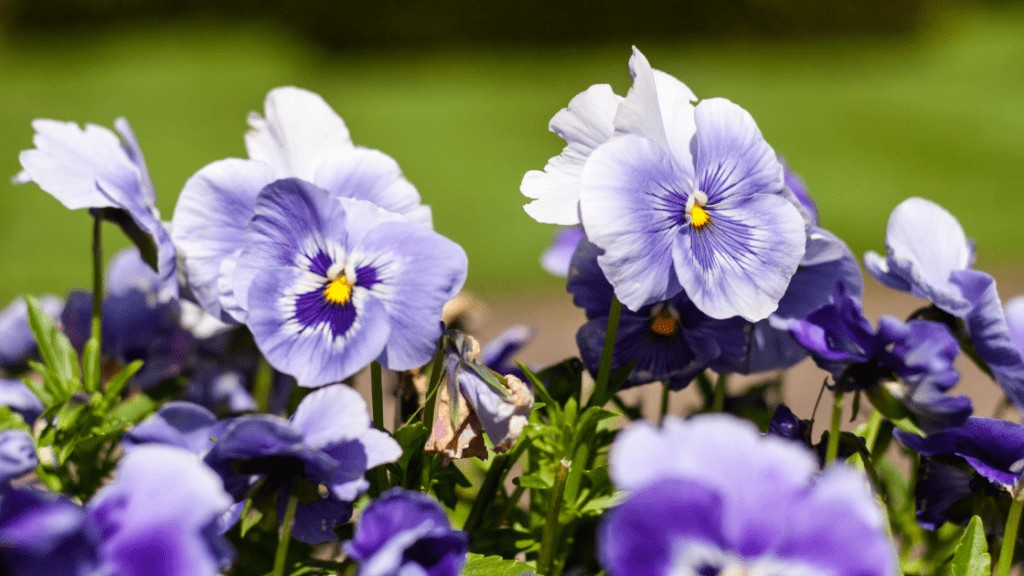
This is another blue-flowering variety, but it’s very different from the ‘Matrix Blue Blotch’.
Its flower petals are more complex in their patterning and feature a few lines that emerge from the dark blotch in the center. The petals are more lightly-colored and are somewhat purple.
‘Frizzle Sizzle Yellow-Blue Swirl’ (Viola x Wittrockiana)
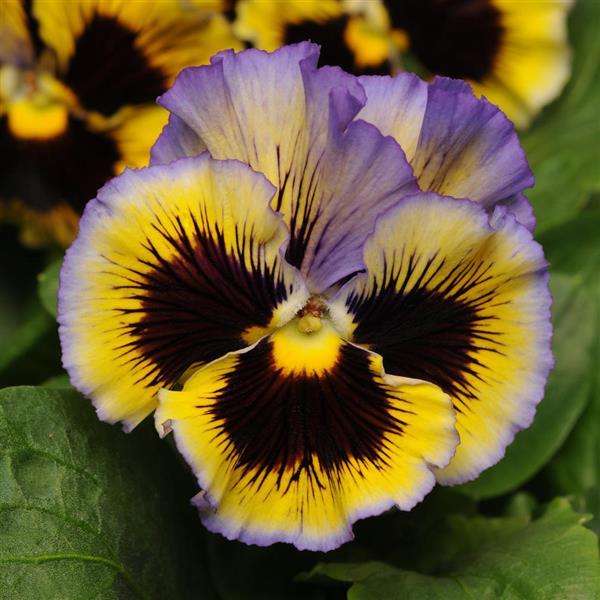
Very similar to the previous variety, but with a larger blotch in the middle and an even lighter petal coloring.
Both varieties are and excellent choice if you’re looking for a non-overpowering, lighter flower color that doesn’t distract too much from the other plants in your garden.
‘Joker Jolly’ (Viola x Wittrockiana)
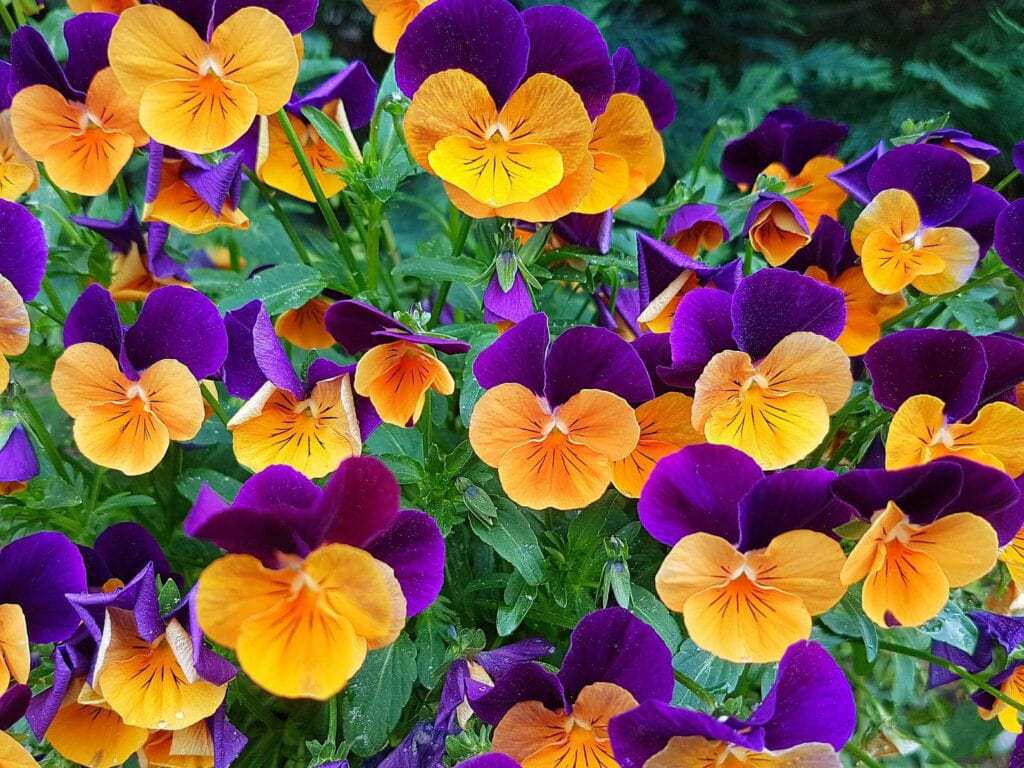
One of the most unique pansy varieties, featuring dark purple petals that sharply transition to orange towards the center of the flower.
This is a very eye-catching variety that can add a colorful look to your garden even with only a few plants. You can find these seeds on Esty by clicking here.
‘Brush Strokes’ (Viola x Williamsiana)
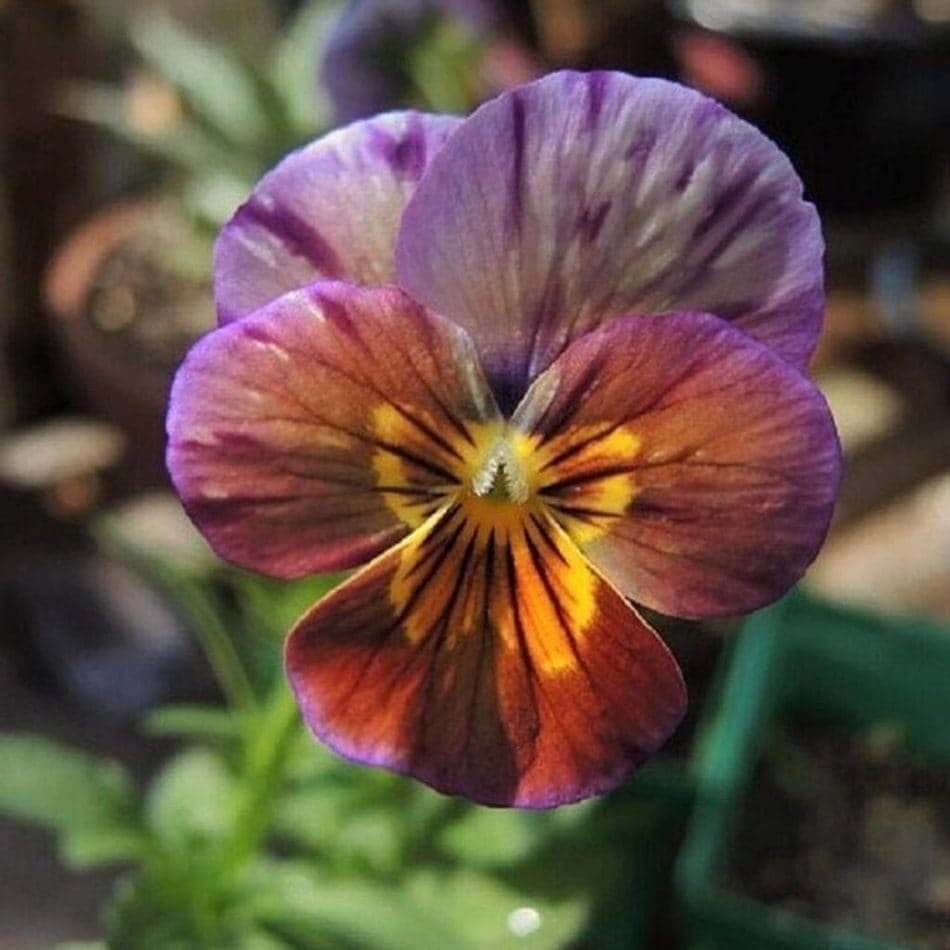
A variety with a pleasing patterning that looks like it was painted with a brush in an outward motion, starting from the center of the flower.
This variety has a somewhat random coloring that depends on the expression of different genes in the plant. Some plants will produce bright, sunflower-colored flowers, while others will develop more of a purple-blue tinge, but all flowers will have a similar-looking blend of yellow and purple-blue. Seeds can be purchased on Esty by clicking here.
‘Johnny Jump-up’ (Viola Tricolor)

Also referred to as ‘wild pansy’, this variety is an ancestor of large-flower Pansy varieties. It has much smaller flowers and unlike other pansy varieties is an actual wild-growing plant that hasn’t been artificially bred and hybridized.
This a very commonly sold variety and it grows very well in tiny pots. It’s flowers usually have dark blue petals at the top, white ones in the middle and a yellow petal in the bottom. However, this variety is actually a collection of several sub-varieties, so a few differently-colored versions are available.
‘Colossus Neon Violet’ (Viola x Wittrockiana)

Being one of the darker Pansy varieties, this variety provides a nice contrast with other lighter-colored flowers in the garden.
It has dark-purple colored petals with a dark blotch in the middle, surrounded by a neon ‘glow’.
Also, check out our pansy affiliates product category here: Pansy Product Category
Growing and Caring For Pansies
Pansies are very easy to care for and they don’t have special requirements. In the next section we’ll go over the optimum growth conditions of the plant, but keep in mind that pansies are forgiving and will grow even in unfavorable conditions.
However, just like all flowering plants, they require bright light and if light-deprived, they will grow slowly and their flowering may be delayed or absent.
Do They Do Better Indoors Or Outdoors?
Pansies grow equally well indoors and outdoors. The only problem with indoor cultivation is the lack of sunlight which will limit the growth rate of the plants.
If you have a bright window, they will still grow and flower well. Pansies are hardy down to USDA zone 4, which makes them suitable for planting in an outdoor garden bed. Even in very cold climates, the plants can easily self-seed each year and its roots can survive very harsh frosts.
When growing pansies long-term, starting them from seed is not optional – they tend to live a few years at most, even in the most favorable conditions. Pansies are classified as biennials, which means they will live for two years. However, this is not a strict rule, especially when it comes to indoor plants that are not provided with a winter dormancy period.
Do They Do Well Potted?
Pansies are one of the most widely sold potted flowering plants and they do very well even in small pots, especially if provided with some fertilization.
The plants are small and don’t have an extensive root system, which means there will be almost no difference in growth of potted plants compared to plants planted in an outdoor garden bed.
For more information on plastic and terracotta pots, check out these articles.
How Much Sun Do They Need?
Pansies grow best in full sun but they also dislike high temperatures. When grown outdoors in USDA zones above 7, they may overheat when exposed to the mid-day sun, so it’s best to provide some shade and/or light misting.
This is very dependent on the specific variety and wind conditions. Always be on the look out for any wilting if you’re growing Pansies in direct sunlight.
What Type Of Soil Is Required?
Pansies like a well-aerated soil which also retains a lot of moisture and is constantly damp.
Loam soils with a lot of sand are often used. The best way to achieve a proper balance of aeration and nutrition is to use layering and cover the loam soil with an inch thick compost layer. When watering, compost nutrition makes its way down towards the loam layer without waterlogging the plants.
All that said, pansies will be able to grow in general purpose potting mixes as well and are not that demanding. You can read on on soil, by clicking on our article here. What Are The BEST Potting Soils for Every Type of Plant?
Is Feeding Recommended?
Pansies grow best with regular fertilization with dilute fertilizer solution. A balanced, 20-20-20 fertilizer works well, but it’s best to dilute it to around 1/3rd strength to avoid burning the roots.
Occasional watering with plain water is recommended to prevent buildup of fertilizer salts in the soil. Don’t fertilize your plants if they are planted in a new, fresh soil – doing so will only lead to nutrient burn.
How Often Should They Be Watered?
When it comes to the watering frequency, the general rule for most low-growing flowering plants applies – let the top of the soil dry out a bit between each watering.
Pansies like their root zone to be constantly damp, but also to contain some oxygen. Waterlogging the soil will displace all the oxygen from the root zone, which will suffocate the roots. As a result, paradoxical wilting may occur, which can baffle novice gardeners – the plant appears to lack moisture and the more you water, the worse it gets.
Propagation
Pansies can be divided or they can be propagated by cuttings. However, the most efficient propagation method is via seeds. Each flower, after it’s pollinated will produce a seed pod containing about 50 seeds, most of which will germinate successfully when placed in damp soil.
Pansy seeds are best sprouted in the dark and bright light may inhibit their germination. It’s best to start pansy seeds a month or two before winter is over – that way, you’ll have ready to be planted plants as soon as the frosts are over. If you choose to propagate your pansies via root division or via cuttings, keep in mind that they are classified as biennial plants, which means they only live for two years.
Any vegetative propagation will preserve the age of the plant, which means that propagation via seeds is not optional if you want to keep growing Pansies for more than 2-3 years.
When Do Pansies Bloom?
Pansies are classified as ‘facultative long-day plants’. This means that they aren’t fully dependent on day length in order to initiate flowering, but longer days will stimulate flowering and make it happen faster.
Interestingly enough, high temperatures may inhibit flowering and when pansies are grown in warm climates (above USDA zone 7), they tend to flower during spring and then once again during autumn. This is a somewhat unique in ornamental gardening plants, but not completely unique – snapdragons and sunflowers have a very similar annual blooming behavior.
When pansies are grown indoors and longer days are simulated with an artificial light, they may flower profusely year-round until they get exhausted and die.
Common Issues You May Encounter
Pansies are cool-weather plants and many of the problems you may experience when growing them will come down to heat stress.
They do best with soil temperatures of around 60F (15C), which can be impossible to achieve in many regions. When pansies are growing tightly, they provide a lot of shade to the soil, keeping it relatively cool.
Sparse-growing plants however may let too much light through, warming up the soil. Providing constant moisture on the soil surface can provide evaporative cooling and solve this problem, but make sure not to waterlog the soil.
Fungal Diseases
Part of the reason why Pansies don’t tolerate high temperatures is that it makes them vulnerable to fungal infestations.
High temperatures and high humidity both make it easy for fungi to grow. The most common fungal diseases which affect Pansies are Anthracnose, powdery mildew and Botrytis. Both Anthracnose and Botrytis create brown leaf spots that can be difficult to diagnose and may look like dehydration to novice gardeners.
Fungal problems can be difficult to eliminate and it’s best to prevent them in the first place, by avoiding water accumulation on the foliage of the plants.
Root Rot
This problem is not unique to Pansies and affects most other low-growing flowering plants when soil conditions are sub-optimal.
High soil temperatures reduce the oxygen content of the soil and greatly speed up the growth of pathogenic root rot organisms such as Phytophthora. However, root rot can set in even in low temperatures if the soil is compacted and waterlogged.
Plant roots consume oxygen in order to manufacture energy for the transportation of water and when they are oxygen-deprived because of over-watering, they start dying. Dead root tissue is soon invaded by root rot organisms and in certain conditions, the problem can go rampant, killing the plant.
Root rot starts without any symptoms, but the plant soon starts wilting and the more it’s watered the worse the wilting gets. Once the problem reaches that stage, it can be difficult to eliminate and repotting may be necessary. To avoid root rot, choose a well-draining soil and don’t overwater.
Pests
Pansies aren’t particularly vulnerable to pests, but stressed plants may get invaded by Aphids or Spider Mites.
Insect pests are relatively easy to get rid of by using commercial insecticides. Slugs also like feeding on Pansy leaves and the only way to prevent that is to keep an eye out for them and physically remove them.
Final Thoughts
Pansies are one of the most eye-catching flowering plants – they are suitable both for indoor and outdoor cultivation and are very easy to grow and propagate. However, they don’t like high temperatures and grow best at a temperature of less than 70F (20C).
In high USDA zones (above 7), pansies will suffer from some heat stress during the summer, making them vulnerable to pests and diseases. In warm climates, it’s typical for pansies to flower during the spring and then again during the autumn, which means that high temperatures inhibit their blooming. It’s important to keep in mind that Pansies are biennials and they don’t live for very long, regardless of what conditions they are provided with.
Related Products
